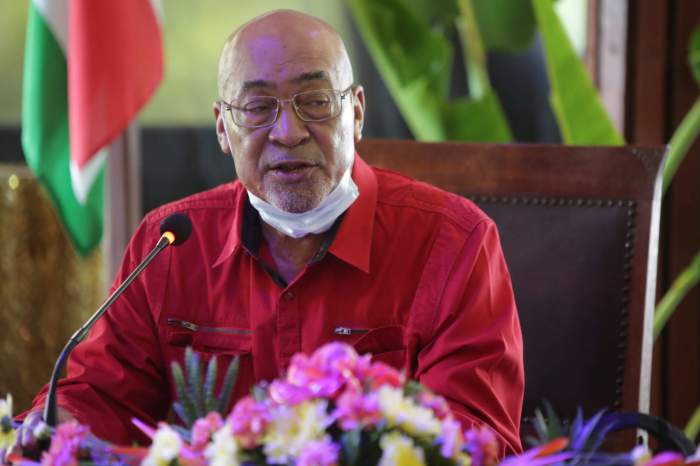KYIV, Ukraine (AP) — Russian and Ukrainian troops appeared Thursday to be girding for a major battle over the strategic southern industrial port city of Kherson, in a region which Russian President Vladimir Putin has illegally annexed and subjected to martial law.
Fighting and evacuations were reported in the Kherson region as Moscow tried to pound the invaded country into submission with more missile and drone attacks on critical infrastructure.
Putin declared martial law in the Kherson, Luhansk, Donetsk and Zaporizhzhia regions on Wednesday in an attempt to assert Russian authority in the annexed areas as he faced battlefield setbacks, a troubled troop mobilization, increasing criticism at home and abroad, and international sanctions.
The unsettled status of the illegally absorbed territory was especially visible in the Kherson region’s capital, where Russian military officials have replaced Kremlin-installed civilian leaders as part of martial law that took effect Thursday to defend against a Ukrainian counteroffensive.
Kherson city, with a prewar population of about 284,000, was one of the first urban areas Russia captured when it invaded Ukraine, and it remains the largest city it holds. It is a prime target for both sides because of its key industries and major river port. Reports of sabotage and assassinations of Russian-installed officials in Kherson have surfaced for months, in what appeared to be one of the most active Ukrainian resistance movements in occupied territory.
Russian-installed officials have urged residents to evacuate for their safety and to allow the military to build fortifications. Officials said 15,000 residents of an expected 60,000 had been relocated from the city and surrounding areas as of Thursday.
President Volodymyr Zelenskyy’s office said Thursday that Ukrainian forces mounted 15 attacks on Russian military strongholds in the Kherson region. For its part, Russia’s Defense Ministry spokesman said the Kremlin’s forces repelled Ukrainian attempts to advance with tanks on the Kherson villages of Sukhanove, Nova Kamianka and Chervonyi Yar.
A Russian-installed official in the region, Vladimir Leontyev, said Thursday Ukrainian forces had launched five missile strikes against the Kakhovka dam and hydroelectric power station about 70 kms (44 miles) from Kherson city. He said on Russian TV that if the facilities were destroyed, a critical canal providing water to annexed Crimea would be cut off.
Zelenskyy countered that the Russians have mined the dam and power station, with plans to blow them up in what he called a terrorism act to unleash 18 million cubic meters (4.8 billion gallons) and flood Kherson and dozens of areas where hundreds of thousands of people live. He told the European Council Russia would then blame Ukraine.
None of the claims could be independently verified.
Russia’s new military commander in Ukraine this week acknowledged the threat posed by Ukraine’s counteroffensive to Kherson, and Britain’s Defense Ministry interpreted that Thursday to mean, “Russian authorities are seriously considering a major withdrawal of their forces from the area west of the Dnieper River.”
Putin tried Thursday to address another problem area, the partial mobilization of reservists he ordered last month and estimated it would end by the end of this month by reaching its 300,000-man target. He visited a training center in the Russian region of Ryazan to show progress in rectifying problems with training and supplies for newly mobilized troops. Russian TV showed him lying under a net on a field, wearing goggles and ear protection, and shooting a rifle. A military officer showed Putin and Defense Minister Sergei Shoigu soldiers wearing bulletproof vests and helmets, with weapons. The officer displayed winter boots, clothes, cooking utensils and other supplies — all to counter images Russians have posted on social media of shabby or non-existent gear for newly mobilized troops.
In another sign of Russia’s wavering mobilization, Ukrainian authorities said more than 3,000 Russians have called a hotline for soldiers who don’t want to take part in the war and are asking to surrender.
In other developments:
—Russian forces attacked Ukrainian positions near Bilohorivka, a village in eastern Ukraine’s Luhansk region. In the neighboring Donetsk region, fighting raged near the city of Bakhmut. Kremlin-backed separatists have controlled parts of both regions for 8½ years.
—Russia continued attacking energy infrastructure, dispatching drones and missiles to eight regions, prompting authorities to ask residents to reduce energy consumption from 7:00 a.m. to 11:00 a.m. and to dim city street lights. They warned of rolling blackouts continuing Friday. In Kryvyi Rih, Russian strikes damaged a power plant and another energy facility, cutting electricity to the central Ukraine city of about 600,000 residents. Kryvyi Rih is home to metallurgical factories key to Ukraine’s economy. Gov. Valentin Reznichenko said the city sustained serious damage.
—Ukrainian authorities said missile and drone strikes started fires in the southern city of Mykolaiv, with four drones hitting a school. Another school in Komyshuvakha, a village in Zaporizhzhia, also took four drone strikes.
—The Ukrainian army’s general staff reported a heightened chance that Russian forces could attack from Belarus to cut supply routes for Western weapons and equipment. Oleksei Hromov, a general staff official, said Russia was deploying aircraft and troops in Belarus.
—The White House said Iranian troops are “directly engaged on the ground” in Crimea supporting Russian drone attacks, troubling evidence of Tehran’s deepening role assisting Russia as it exacts suffering on Ukrainian civilians just as the cold weather sets in.
—Despite the Kremlin’s — and Iran’s — claims to the contrary, a leading Russian military expert unwittingly acknowledged that Iran has supplied Russia with weaponized drones it uses in Ukraine. Ruslan Pukhov, head of the Center for Analysis of Strategies and Technologies, a Moscow-based think tank, asked journalists before a TV interview not to question him about where the drones came from, unaware that he was live on air. “We all know that they are Iranian-made, but authorities haven’t acknowledged that,” Pukhov said.
—The EU on Thursday imposed sanctions on Iran’s Shahed Aviation Industries, as well as three Iranian armed forces generals, for undermining Ukraine’s territorial integrity by helping to supply Russia with drones.
Lorne Cook in Brussels, Amir Vahdat in Tehran, Yuras Karmanau in Tallinn, Estonia, and Andrew Katell in New York contributed to this report.
Follow AP’s coverage of the war in Ukraine: https://apnews.com/hub/russia-ukraine

























